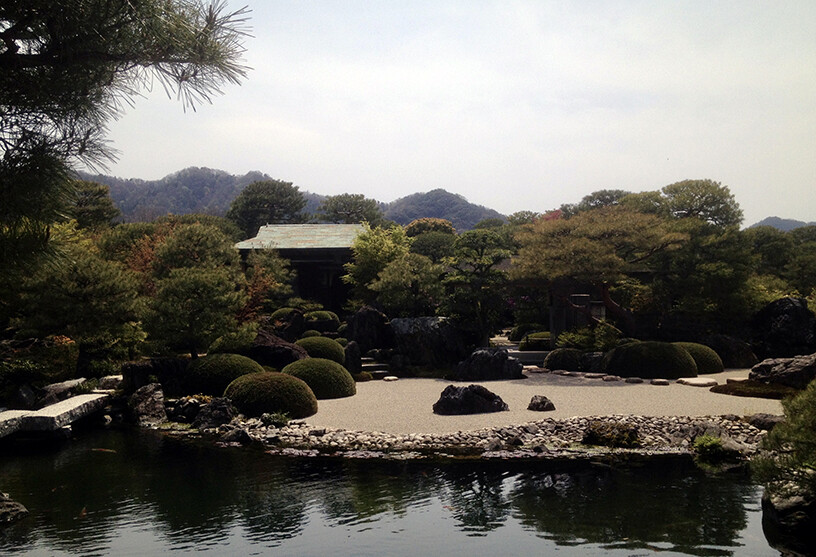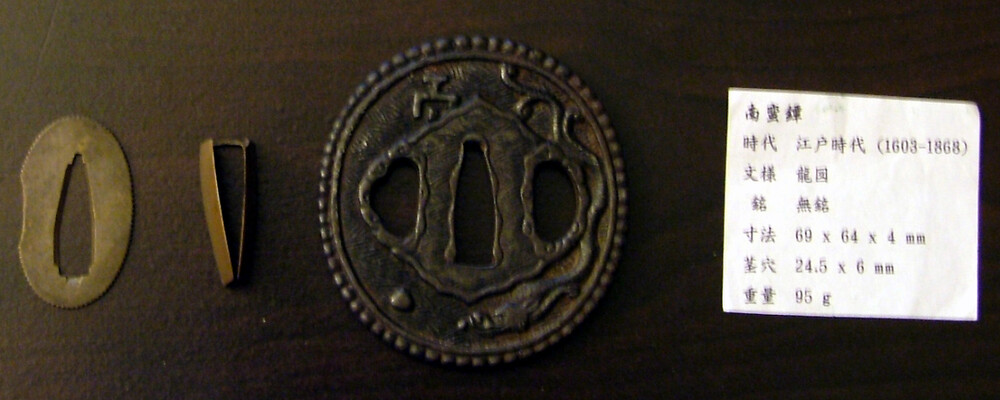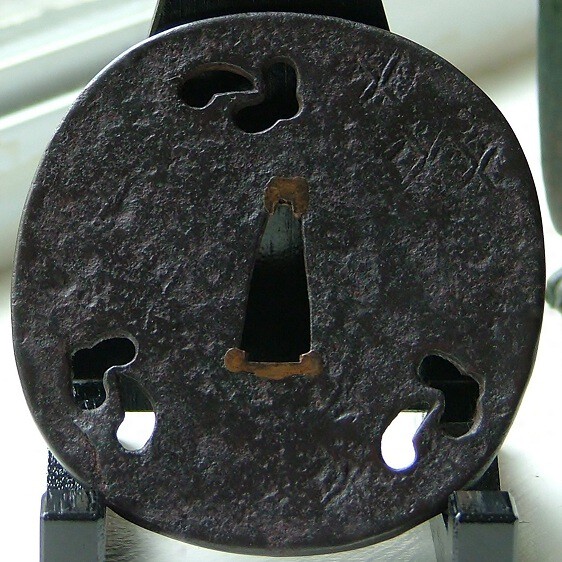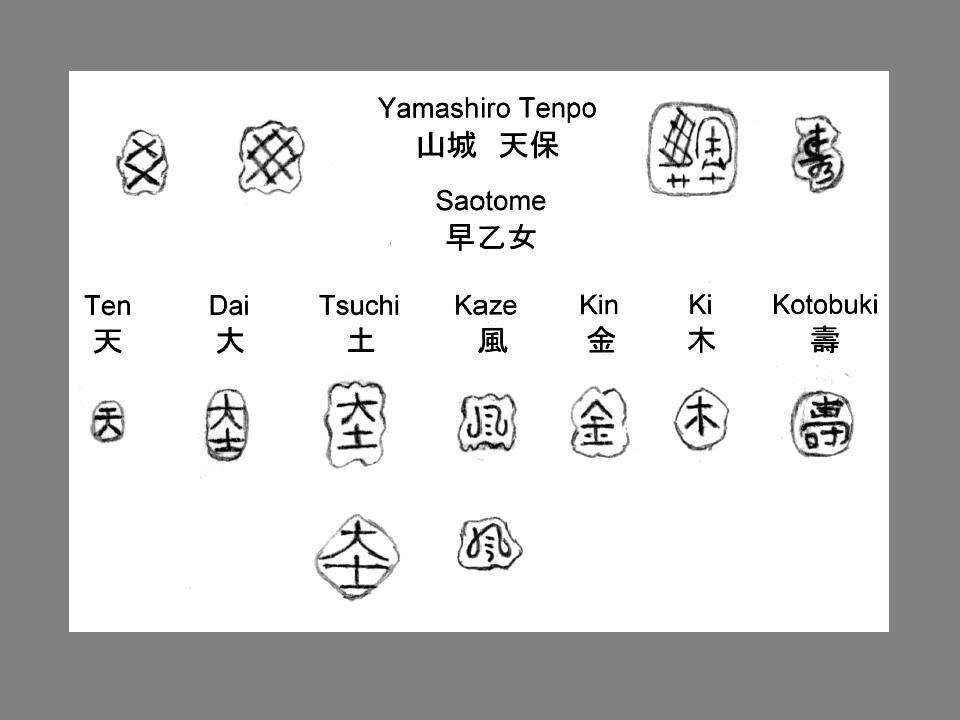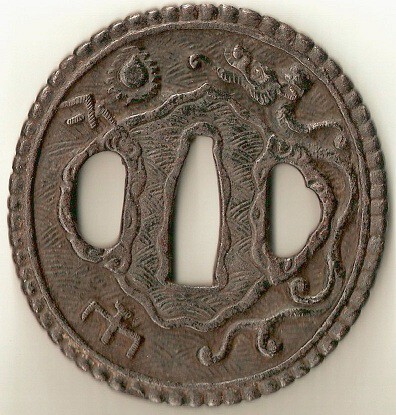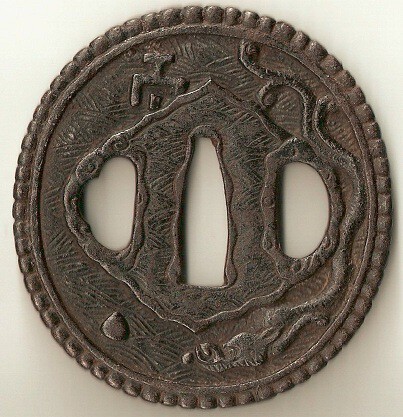-
Posts
2,875 -
Joined
-
Last visited
-
Days Won
3
Everything posted by Soshin
-
Purchased my book direct from Markus S. and it was a very enjoy and informative read. Just the thing I need for my research. Yours truly, David Stiles
-
Hi John B., Nice Saga Kaneie school tsuba. I really like the design. The waves reminds me of a Umetada Shigenari tsuba I have. Shigenari often made tsuba in a Kaneie style but was a member of the Umetada school around the time of the sixth generation master Shigeyuki (ca. 1700). Here is a photo of the Shigenari tsuba I have for comparison. Both Shigenari and Saga Kaneie school often used nunome-zogan style gold inlays. Thanks for sharing. Yours truly, David Stiles
-
This year show was really great and I enjoyed myself greatly. I was allowed to start matching faces with names outside of my local Japanese sword club of Maryland and Northern Virginia. I am very much looking forward to this show in early 2012 and will be submitting something to the NTHK shinsa as well. Yours truly, David Stiles
-
Hi Thomas, Thanks for the write up and research you did about the tsuba and swordsmith who made it. These type of research projects I find really interesting to read and discuss. Yours truly, David Stiles
-
Hi Pete, Thanks for sharing the two fine examples of Onin school work. Its remarkable how well preserved the brass work is on both tsuba. Yours truly, David Stiles Yours truly, David Stiles
-
I see some rust pitting consistent with age disrupting some of the chisel marks. I would say it is likely from the later part of the Edo Period. Having a 2/3 photo close up of the rim would be helpful in confirming age as I will be able to get an idea of the type of iron used in the tsuba. Often much can be determine age wise based on the type of iron used but not always. There were a few schools in the late Edo Period trying to recreate earlier styles by using very heterogeneous iron. Also a complete set of measurements including thickness would be helpful on the tsuba as well. Yours truly, David Stiles
-
The tsuba is finished with a technique call kesho-tagane which are decorative or ornamental chisel marks. Your tsuba chisel marks are in the common shape of a chrysanthemum. As to what school the tsuba belongs to I am not sure. But I have heard that kesho-tagane could sometimes be used to identify specific tsuba-ko when they were done in characteristic patterns along the seppa-dai and nakago-ana. I hope you find some of this information helpful. Yours truly, David Stiles
-
Keith's G. point is generally true but before the Edo Period all brass was imported from China and so brass was at times around the same price as gold was in pre Edo Period Japan. This was due to the lack of natural zinc deposits in Japan required to make brass. The Heianjo-zogan, Yoshiro, and Onin school guards with there brass inlays were the tsuba often worn by the wealthy and the upperclass located in and around Kyoto. Yours truly, David Stiles
-
I would agree completely with your point. At the Hozon level for Nihonto and tosogu the primary goal is authentication following by attribution to a specific person or group of artisans that were active during a specific time period. Anything beyond that is a bit outside the scope of the shinsa. Thanks for the discussion. Yours truly, David Stiles
-
Hi Christian, Nice tsuba Christian! Here is a link: http://www.e-sword.jp/sale/2010/1010_6055syousai.htm to a Yagyu, Ko-dai tsuba displaying a classic design motif (i.e. moon reflection below ocean waves). In terms of the iron including tekkotsu, visible lamination, patina, and even the technique used to carve the design (i.e. Sukidashi-bori) it is the same as my tsuba. Basically what I am saying is that this Yagyu, Ko-dai tsuba was made in Owari by the Futogoyama school it is only Yagyu, Ko-dai on the shinsa paper because the motif can easily associated with the known (by outsiders myself included) principles of the swordsmanship school. This is going back to a comment I remember hearing at the Florida Token Kai this year when showing photos that basically the Yagyu Shinkage ryu being samurai wouldn't have coins designs on their tsuba. Showing my tsuba to someone who had practiced Yagyu Shinkage Ryu swordsmanship since the mid 1980s he was able to understand motif and how it related to the principles of the swordsmanship school. Could my shinsa result be of the NBTHK shinsa panel just trying to identify the maker and time period of the tsuba without trying to understand the design motif and how it relates to principles of the Yagyu Shinkage swordsmanship school? Either way I am not in anyway upset with the outcome of the shinsa and am really happy but just trying to deepen my understanding. Yours truly, David Stiles
-
Can across this on a another Japanese sale site: http://www.e-sword.jp/sale/2010/1010_6020syousai.htm. The craftsmanship which is a good attribution point looks very similar to my tsuba even when some of the techniques are different. For example the type of "iron bones" along the rim and color of the patina are very similar. I really like Owari tsuba! :D Yours truly, David Stiles
-
Hi Elliott, Here are some other photos from when I sold my tsuba. When I purchased it in Japan it came with a copper Habaki, seppa that fit it nicely and a collectors note in Japanese. The habaki and seppa looked like it would fit a wakazashi nicely. The collectors note said "Nanban Tsuba", Edo Period" with measurements but I listed it as Meiji or Taisho Period vintage piece as I couldn't confirm the date it was made. Unfortunately I cannot attend the San Francisco Token Kai. The next show I will be at will be next year's Florida Token Kai for the NTHK Shinsa. Thanks for posting some of Bob Haynes writing on your website I enjoy reading them. Yours truly, David Stiles
-
I would agree Rich T. posted some really nice tsuba. Each one is a very nice example of the specific school. Thanks for sharing. Yours truly, David Stiles
-
Just wanted to bump this thread up about my write up I am doing for my new Saotome tsuba. I was reading in Sasano's second book "silver dust cover" that he believed the mushroom matsutake in Japanese characterized by rapid overnight growth and lack of roots symbolic. The examples he sits are mostly Ko-Tosho and Ko-Katsushi tsuba from the Kamakura and Muromatchi Periods. As I have been reading a book on Samurai history could this be somewhat of a mild form of social commentary of the Kamakura and later Muromatchi Bafuku? While I would date my tsuba to the late Muromatchi Period the same symbolism could be in play here as the mushroom shape is done in a similar manor as the Ko-Katsushi tsuba examples from the Muromatch Period. Just some questions and food for thought. Yours truly, David Stiles
-
Hi Ed F., Q86 is a nice Ko-Kinko tsuba likely dating to the Momoyama Period. I don't think it is Goto. If you have seen examples of Ko-Goto or Goto tsuba you would know that I mean. I mean this with all due respect. Signs of what I think is worn black lacquer can be observed on both sided. These type of tsuba were often lacquered before the Edo Period. Not completely sure unless I can see it in hand. Please do not try to clean this tsuba in anyway! The other tsuba not sure but others have commented on them. I hope you find this information helpful. Yours truly, David Stiles
-
Hi Ed F., Tsuba Q95 I think is likely a work of the Ito school of Bushu (i.e. Edo). From the looks of the tsuba I would say likely late Edo Period. But Looking up the tsubako name Masatsune in Haynes Index of Japanese Sword Fittings and Assoicated Artists would be the next logical next step to find out the production period for Masatsune of (Bushu) Ito school. As for the other tsuba (Q91) I don't know much about it but I also don't think it is very old. I would say it is also very likely Edo Period. This tsuba I think is not made out of Yamagane unrefined copper but Suaka refined copper with a patina applied. If it must be classified I would just say that it belongs to the large group known as Kinko. I hope you find the information I have offered helpful in your research. Just my two cents. Yours truly, David Stiles
-
Here are some scans of this "tsuba" I owned at one time. I sold it on eBay as a vintage cast iron Nanban style copy. I orginally purchased in Japan. This one like all of the others are just vintage cast iron copies. Yours truly, David Stiles
-
Hi Everyone, Just wanted to post some nice photos of a early Saotome school tsuba I purchased recently. I really like how the photos have turned out using nature sunlight as the light source. The collectors note that came with the tsuba says Momoyama Period but I would like to venture a guest that the tsuba might be as old as the late Muromachi Period. The Ko-sukashi mushroom design along with "net" style kokuin is classical to the early Saotome school. The "net" and Kanji style kokuin or hot stamp was also extensively used later by the Tempo school during the Edo Period. The style of rim is turned up and hammered back is referred to in Japanese as sukinokoshi-mimi and if often observed in Saotome and Tempo school tsuba. The measurements of the tsuba are 8.5 cm by 8.1 cm. The thickness at rim is about 3.5 mm. The thickness at the rim is greater then the thickness at the seppa-dai. Any comments, questions, and discussions are welcome. Thanks for viewing. Attached is a diagram I found of common kokuin or hot stamps found on Satotome and Tempo school tsuba. Yours truly, David Stiles
-
Here is a cast iron Nanban tsuba reproduction I sold on eBay as a cast iron reproduction of a Nanban tsuba that I purchased a while ago. I sold it for about $10.00 USD. I don't think real antique Nanban tsuba were made of cast iron. Mostly for the reasons outlined above. Some might have a look of being cast iron but that is likely just because they are made from wrought iron from foreign sources back in the Edo Period. Again just my two cents on the topic. Yours truly, David Stiles
-
Hi Ford, I have examining both of my Nanban tsuba under low magnification of a hand glass. I can clearly see signs of chisel work on the surfaces most notable the seppa-dai on one of my tsuba and main motifs on the other. The openings of wrought iron surface also show evidence that they were drilled. The two Nanban tsuba in my collection show no signs of being cast. As I have a interest in the Nanban tsuba group I should collect more to examine and study. :D Yours truly, David Stiles
-
From the second image the brass looks of the very old type in terms of the color. I later reproduction would have very bright brass inlays after cleaning the surface with soap and water and not this dull color. The dull color is caused by inpurtites in the imported Chinese brass that the Japanese used originally in their inlay work. Just my two cents. Thanks for sharing. Yours truly, David Stiles
-
Hi Mark G., I have did some research per your request and haven't found any. Nanban tsuba are generally not signed and because they were produced in Nagasaki, Hirado, Kyoto, Osaka, Edo, Aizu, and other places it is often difficult to impossible to determine the origin of a piece. In the Token Bijutsu issue number 646 that I have specifically focused on them the NBTHK don't provide any signed examples. Two other issue I have Nanban related or influenced schools and while some of those are signed none are dated. Here are two quote from the translation of issue that might be useful to the discussion. Historically Nanban tsuba were first discussed in Kinko-tanki published in the year 1839. I hope what little information I have found is helpful. Yours truly, David Stiles
-
Hi Thomas H., I was going to complain about how long this thread is but then I had to reply being a fan and collector of Nanban tsuba. All Nanban reproductions I have seen are made of cast iron. I have observed antique Edo Period Nanban tsuba and are cast iron and others that show signs of forging of relatively homogeneous iron. After reading three issues on Nanban tsuba in the Token Bijutsu monthly magazine I have come to the conclusion there isn't any shortage of wonderful high quality Nanban tsuba out there and likely some of them are made of cast iron. Do I think casting was often used to make tsuba? No. Could it have been? I don't know enough to answer that question completely but some members of NMB have provided some very helpful information. Yours truly, David Stiles
-
I came across this similar tsuba to my recently papered tsuba: http://www.tsubanomiyako.jp/SHOP/T-069.html. The iron, patina, size, and general craftsmanship is very similar to my tsuba. The presence of tekkotsu on the mimi are are also very similar. The tsuba in the link is not papered. Yours truly, David Stiles
-
A good example of what Chris is referring to are the Kyo Sukashi tsuba of the middle Edo Period. Think very intricate and delicate sukashi open work designs made with fairly homogeneous iron often without tekkotsu. The good quality Nanban tsuba are also appreciated for their design, carving, and motifs and iron fairly homogeneous as well. To address earlier posts casting by Kagamishi of Bronze is will documented and know in pre-modern Japan. This doesn't in any way support the use of iron casting techniques in making tsuba. Yours truly, David Stiles

